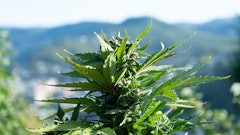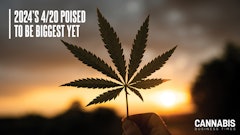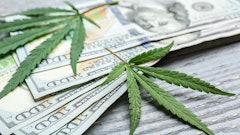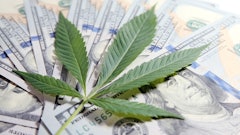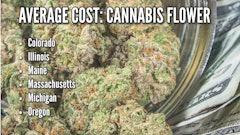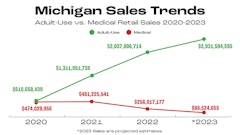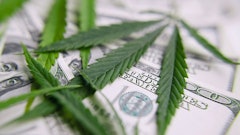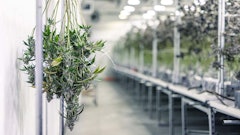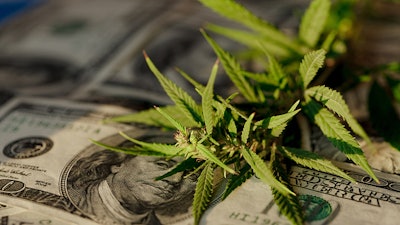
Oregon has fallen from the ranks of billion-dollar cannabis markets.
Licensed retailers in the Beaver State recorded just more than $995 million in overall cannabis sales in 2022, a 16% decrease from 2021, according to monthly figures from the Oregon Liquor & Cannabis Commission (OLCC). Those figures are subject to change slightly based on amended reporting.
Oregon missed the billion-dollar benchmark after recording more than $1.1 billion in sales in 2020 and nearly $1.2 billion in 2021. Since the state launched a commercial adult-use retail market more than seven years ago, 2022 marks the first time that sales did not increase.
The unprecedented downtrend is the result of a market correction following record sales growth during a pandemic boom for the cannabis industry. Oregon’s monthly sales averaged more than $99 million from March 2020 to May 2021—during the boom—representing a 49% increase from the nearly $67 million monthly average from January 2019 to February 2020 (a pre-COVID baseline).
Now in the post-pandemic correction, Oregon’s combined adult-use and medical cannabis sales averaged nearly $83 million per month in 2022.
RELATED: Year-Over-Year Cannabis Sales Shrink for First Time in 5 States
Broken down by customer, adult-use shoppers accounted for $932.5 million in sales for 2022, while medical patients spent $62.7 million (good for 6% of the overall market).
| Year | Adult-Use | Medical | Combined |
|---|---|---|---|
| 2022 | $932,449,072.26 | $62,716,692.09 | $995,165,764.35 |
| 2021 | $1,084,419,088.65 | $99,671,207.50 | $1,184,090,296.15 |
| 2020 | $1,001,772,323.73 | $109,255,234.20 | $1,111,027,557.93 |
| 2019 | $726,003,565.94 | $69,130,251.65 | $795,133,817.59 |
| 2018 | $584,635,176.55 | $63,757,258.58 | $648,392,435.13 |
| 2017 | $423,949,620.66 | $69,881,980.62 | $493,831,601.28 |
| Total | $4,753,228,847.79 | $474,412,624.64 | $5,227,641,472.43 |
The 2022 sales decline came at a time when Oregon regulators implemented a cannabis licensing moratorium in response to a crowded marketplace after state lawmakers passed House Bill 4016 in March and former Gov. Kate Brown signed it into law the following month. The moratorium does not apply to licensing renewals or affect a change in location or ownership for current licensees, according to the bill.
As of Dec. 7, 2022, there were nearly 2,900 active cannabis business licenses in the state, including 833 adult-use retailers, or roughly 19.6 dispensaries per 100,000 people—the highest rate among Western states in the continental U.S. California, by comparison, was still below 3 dispensaries per 100,000 people at the midpoint of last year.
In addition to the 833 retailers, Oregon’s business footprint also includes 1,422 cannabis producers, 279 wholesalers and 333 processors with active licenses, according to OLCC.
Despite the moratorium, the average sales figures per retailer have trended down in recent months, from nearly $163,000 per dispensary in March 2022 to roughly $104,000 per dispensary in November 2022—the lowest average since April 2019—according to OLCC.
Much of that dip is attributed to falling flower prices, which were at an all-time low of $116 per ounce on average at retail in November and December, a 15% decrease from the beginning of 2022 and a 28% decrease compared to an October 2020 pandemic peak of $160 per ounce, according to OLCC.
Average wholesale flower prices also dipped to an all-time low of $550 per pound in December, a 42% decrease from the beginning of 2022.
As far as product categories go, some price points have remained less volatile than flower. For example, the median price for extracts/concentrates was $16 per gram in December, a 4% decrease compared to the beginning of 2022, according to OLCC.
And while flower products still made up 50.5% of overall sales in 2022 at roughly $502 million, the concentrate/extract market share grew to roughly 25%. And edibles/tinctures made up 13% of the market in 2022, according to OLCC.
Here’s a rundown of market share by product category over the past six years:
| Year | Flower | Concentrate/Extract | Edible/Tincture |
|---|---|---|---|
| 2022 | 50.5% | 24.9% | 13.2% |
| 2021 | 54.7% | 24.6% | 11.1% |
| 2020 | 58.0% | 25.3% | 9.8% |
| 2019 | 53.7% | 26.4% | 10.2% |
| 2018 | 54.0% | 29.3% | 10.4% |
| 2017 | 65.3% | 24.1% | 8.7% |









